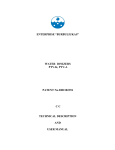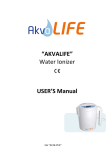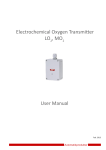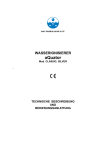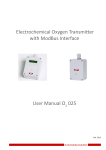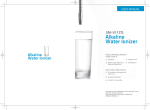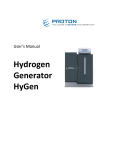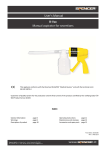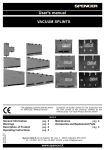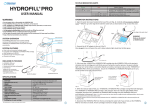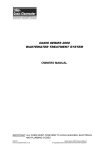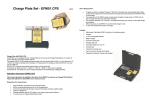Download Instruction - Burbuliukas
Transcript
ENTERPRISE €BURBULIUKAS• WATER IONIZERS PTV-KL, PTV-AL PATENT No.2002102394 CE TECHNICAL DESCRIPTION AND USER MANUAL 1. GENERAL REFERENCES 1.1. Terminology: 1.1.1. Water ionizer PTV € a device in which ionized or silvered water is produced during water electrolysis. 1.1.2. Ionized water € alkaline and acidic water is obtained at one time in separate containers of water electrolyzer. 1.1.3. Alkaline water (catholyte) € has a weak negative electrical charge and has alkaline features. It is otherwise called live water. 1.1.4. Acidic water (anolyte) € has a weak positive electrical charge and has acidic features. It is otherwise called acidic or lifeless water. It is otherwise called dead water. 1.1.5. Partition (diaphragm) € divides the container into two parts, transmits ions, and doesn•t allow mixing of water. 1.1.6. Silvered water € water having silver ions concentration of which is measured in milligrams per liter (mg/l). 1.1.7. The device meets electrical safety and safety requirements. 2. TECHNICAL CHARACTERISTICS Two types of devices with timers are produced: modification KL € for production of ionized and silvered water; and modification AL € for production of ionized water only. Their technical characteristics are provided in the chart. Values of Parameters Title of parameters Capacity of container, l Power supply voltage, V~ Alternating current frequency, Hz Fuses, VP,A Average duration of electrolysis producing: ionized water, min silvered water, sec Mass of silver electrode (purity 999,9), g Power used in producing: ionized water, W silvered water, W Mass of the device does not exceed, kg Using conditions: air temperature relative air humidity mains water temperature degree of protection against water getting in Dimensions of devices, mm It must not be disposed of with common household waste KL 1,4 230 50 2 AL 1,4 230 50 2 6 2-3 9,7+/-0,1 6 - 100 3 1,3 100 1,2 5 to 40oC to 80% at 25oC 10 to 25oC IPX 1 190 x 160 x 200 5 to 40oC to 80% at 25oC 10 to 25oC IPX 1 190 x 160 x 200 3. PACKAGE Title Water ionizer PTV Removable vessel Technical description and user manual Holder with a round silver electrode Packing box Modification KL 1 1 1 1 1 AL 1 1 1 1 4. DESIGN AND PRINCIPLE OF OPERATION 4.1. 4.2. 4.3. 4.4. The device consists of a lower container (1), a removable vessel (3) and an enclosure (9). (See picture 1) The lower container (1) is an electrolysis container. In the upper part of it two handles are installed. (2) A removable semi round vessel is built in the container (3), in which parchment partition with two plate form plastic retainers are set instead of the front wall (4). Partition is fastened in the top with a fixer (5). On the inner side of the container and the vessel there are two marks: lower (6) indicates minimum and upper (7) € maximum water level. In the enclosure (9) an electrical scheme is installed that is covered from inside with a plastic cover. In the cover flat electrodes (8; 19) and round contact (18;) are fixed. Flat electrodes are meant for production of ionized water and round contact - for connection of silver electrode. On the board (12) located on the top of the enclosure three LEDs are mounted: the middle, green (14), lights when the plug of the device (13) is connected to the power supply socket. The external, red (11; 15) ones, light respectively when ionized or silvered water is produced. As well on the top of the enclosure four buttons for control of timer and working mode and time indicators are mounted (16). On the other side of the enclosure there is a cord with a plug. (13) and switch (20). Parchment partition is fitted between two plastic plate form retainers in such way, that arrows on the outer sides of the plates are directed downwards. Then partitions with retainers (4) is mounted into special notches of the removable vessel (3) and fastened with a fixer (5). 1. Lower container. 2. Handles of lower container 3.Removable vessel 4.Partition with retainer 5.Fixer 6. Mark of lower level of water 7. Mark of upper level of water 8, 19.Electrodes of production of ionized water (flat) 9. Enclosure. 10.Handles of enclosure 11. Red indicator J 12. Decorative board 13.Cord with plug 14.Green indicator 15. Red indicator A 16. Control buttons and indicators of working mode and time 17. Holder with round silver electrode (mod. KL) 18. Contact for connection of silver electrode (mod. KL) 20. Switch 4.5. During water electrolysis acidic water is generated at the black electrode (8) and alkaline water - at the light one (19). Partition (4) of the removable vessel (3) doesn•t allow ionized water to mix. 4.6. When producing silvered water (modification KL), the removable vessel (3) is not necessary. The device control scheme does not allow to switch on the modes of production of ionized and silvered water at one time. 5. PROPERTIES OF IONIZED WATER AND ITS APPLICATION 5.1. 5.2. 5.3. 5.4. 5.5. Alkaline water (catholyte) - a soft, odorless water having taste of rainwater. ORP values are negative (1 table) and pH fluctuates from 8,0 to 11,0 pH (the bigger this number, the more alkaline water is). It is a natural stimulator. Acidic water (anolyte) - water having typical acid and weak chlorine odor. ORP values are positive (1 table) and pH fluctuates from 6,0 to 2,0 (the smaller this number, the more acidic water is). It is a natural bactericide. Ionized water should be kept in tightly closed jars protecting it from direct sunlight. It not recommended to keep it in refrigerator. Alkaline water preserves its properties for up to 3 days and acidic water - for up to 7 days. Properties of ionized water are characterized by two indexes: ORP- oxidation- reduction potential and pH ‚ hydrogen index. ORP is characterized by positive or negative charges (mV) that charge ionized water (respectively anolyte + and catholyte -). pH values can fluctuate between 0 to 14 units. Potable water is neutral, its pH is about 7,0. pH of alkaline water fluctuates from 8,0 to 11,0 pH (the bigger this number, the more alkaline water is) and of pH of acidic water is from 6 to 2,4 pH (the smaller this number, the more acidic water Table 1 presents the dependence of pH and ORP values on appliance running time. These pH and ORP values have been obtained by analyzing water in ICP-MS Measurement Laboratory on Faculty of Chemistry in Warsaw University. ORP values are given relatively to calomel electrode. Research report is stored in the enterprise. Table 1 Tap water Alkaline water Time, min 5 10 15 20 25 30 ORP -815 -886 -896 -905 -911 -914 Acidic water pH 9,66 10,08 10,17 10,22 10,33 10,39 ORP 811 1051 1085 1103 1112 1120 pH 5,07 2,51 2,32 2,21 2,13 2,07 It is essential to know that a negative oxidation - reduction potential acquired by ionized alkaline water lasts a relatively short period of time. Keeping the alkaline ionized water in a closed container from which water is continuously used, after 24 to 36 hours the negative ORP value becomes practically zero or slightly positive. (These water pH values - 8.5 to 9.5 € last a much longer period of time: 4-7 days). Therefore, ionized alkaline water should be used as fresher as possible, or at least it should be used within 12 hours from its production. Shops are available with ionized alkaline water in different containers, as indicated on the label. However, this water, at best, can be considered alkaline, as the ORP value of the water shall not remain negative. 6. PRODUCTION OF IONIZED WATER (MODIFICATIONS AL AND KL) 6.1. 6.2. 6.3. 6.4. Holding the lower container (1) on its handles (2) remove the enclosure (9) of the device. Make sure the partition with retainers of the removable vessel (4) is tightly inserted into the notches of the vessel. Pour cold water from tap: first of all into the removable vessel (3) then into the lower vessel (1) up to the lower marks (6). Put the enclosure (9) on the lower container (1) so that the dark electrode (8) would get into the removable vessel.(3). 6.5. Connect the string type cord with the plug (13) to the socket. Turn on the switch (20). On the enclosure (9) green indicator (14) lights up and in the indicator of timer (16) - letter PH shows. Set the working duration of the device according to the table 1. 6.6. Pushing the control button (16) indicated by arrow ‚ to set the required working time of the device. To reduce the set time push the button (16) indicated by the arrow ƒ. Attention! Working time of the device, while ionizing is set in minutes. 6.7. Push the button START. Red indicator (15) lights up indicated by letter PH. The device starts working. After the set time passes the device switches off automatically. To make a premature cancellation of the work of the device push the button STOP. Note. After the work of the device is finished (when the time of switching on is longer than 3 minutes) a sound signal is given. It is switched off by pushing the button STOP. 6.8. Turn off a switch (20). Pull the plug of the cord (13) from a socket, take off the enclosure (9), pour out from the removable vessel (3) the acidic and then alkaline water into prepared, tightly closed jars. 6.9. Just produced alkaline water is turbid and sometimes foamy. After pouring alkaline water into a jar, sediments and foam precipitate on the bottom, water becomes clear and suitable for using (the amount of sediments precipitated shows the level of contamination of water and they shouldn•t be used). 6.10. Just produced acidic water has a slight acidic and chlorine odor and is sourish. 6.11. When working with the device water can heat up to 40 degrees. 6.12. Wash the removable vessel (3) and lower container (1) with water. It is PROHIBITED to wash with water the enclosure (9) containing the electric part! 6.13. Clean the light electrode (19) and the contact with soft cloth dipped in vinegar. It is not necessary to clean the dark electrode (8). 6.14. Dry the lower container (1), the enclosure (9) and removable vessel (3) without taking out the partition. Assemble the device and store it in dry place. Notes: 1. Use the device strictly to the sequence of operations. 2. For production of ionized water use tap water. 3. It is recommended to pour out (do not use) the produced ionized water after the first use in a new appliance or after the change of the membrane. The membrane is made from a special material suitable for electrolysis. Do not use other materials than those specified by the manufacturer. 4. After taking the removable vessel (3) out of the container (1) the membrane may slightly leak through the bottom of the vessel. It does not affect the production of ionized water. If the leak is more significant - the membrane must be changed. 5. Anode electrode (the dark) is produced by using rare inert metals (ruthenium and iridium) and oxide mixtures on the titanium base. These electrodes have good electrochemical and physical-mechanical properties. Their longevity or life span is very high. Anodes made from any other metal are not suitable for water ionizers as the emission of gases takes place in an acidic medium during the electrolytic. Cl- ions contained in the solution are soluble. In this way metal, from which the electrode is made, complex ions, from which Cr and Ni ions or their compounds are very harmful to human health, enter the acidic water. The dark electrode must be replaced in case of damage of the electrodeƒs covering layer. 7. PROPERTIES OF SILVERED WATER AND ITS APPLICATION 7.1. Silvered water kills microbes, bacteria. Small silver doses (0,01 mg/l) positively affect organism. 7.2. Impact of silvered water depends on concentration of silver ions: the bigger this concentration, the stronger the impact and the more quickly it begins. 7.3. Silvered water preserves its bactericidal properties for several months. 7.4. For production of silvered water potable water is used. It is recommended to use filtered, spring water, or tap water that has settled. 7.5. Silvered water of low concentration is entirely clear, tasteless and odorless. It has to be kept in dark premises. When boiling silvered water silver sediments precipitate and it loses its properties. 7.6. If you regularly drink silvered water, its• concentration can not exceed 0,01 mg/l (UN 48-1994.). Such concentration is obtained when device is turned on for 2 seconds (see 2 table). Table 2 Work duration (sek.) 2 sek. 5 sek. 10 sek. 15 sek. 30 sek. 60 sek. Concentration of silver water, mg/l Work duration (min.) Concentration of silver water, mg/l 0,010 0,027 0,056 0,082 1,170 0,339 5 min. 10 min. 15 min. 20 min. 30 min. 40 min. 60 min. 90 min. 108 min. 1,671 3,315 5,022 6,613 9,950 13,27 20,00 30,00 35,00 8. PRODUCTION OF SILVERED WATER (MODIFICATION KL) 8.1. 8.2. 8.3. 8.4. 8.5. 8.6. 8.7. 8.8. 8.9. 8.10. 8.11. 8.12. Holding the lower container (1) on its handles (2) remove the enclosure (9) of the device. Put the holder with the round silver electrode (17) on the contact (18) located on the enclosure (9). Take out the removable vessel (3). Pour water into the lower container (1) up to the lower mark (6). Put the enclosure (9) on the lower container (1). Connect the plug of the string type cord (13) to the electricity supply socket. Turn on the switch (20). Green indicator (14) on the enclosure must light and letter S must appear in the timer indicator (16). From the table 2 choose duration of working time of the device. Working time of the device until 1 minute is set in seconds, from 1 to 40 minutes in minutes. Pushing time indicator button (16) indicated by arrow ‚ to set the time of electrolysis. To reduce the set time push the button (16) indicated by the arrow ƒ. Push the button START. Red indicator (11) lights up indicated by letter J. The device starts working. After the set time passes the device switches off automatically. To make a premature cancellation of the work of the device push the button STOP. Pull the plug of the cord (13) from a socket, take off the enclosure (9), pour out the silvered water into the non-transparent, tight jar that has to be stored in a dark place. Carefully clean the silver electrode (17) and the light flat electrode (19) with a soft cloth dipped in vinegar. Dark varnishes occurring on the silver electrode do not influence the quality of silvered water. Dry the lower container (1) and the enclosure (9). Assemble the device and store it in dry place. When producing silvered water for a longer time period dark spots occur on the bottom of the lower container (1). It is a residual effect of silver sediments. These spots do not influence the quality of silvered and activated water and further exploitation of the device. It is PROHIBITED to wash with water the enclosure (9) containing the electric part! 9. SAFETY REQUIREMENTS 9.1. 9.2. 9.3. 9.3.1. 9.3.2. 9.3.3. 9.3.4. 9.3.5. The device can be connected to the power supply when the lower container (1) and the removable vessel (3) are filled with water and the enclosure (9) is put on. The device should be protected from children and shouldn•t be left without attendance. IT IS PROHIBITED: To remove the enclosure (9) from the lower container (1) when the device is connected to the power supply. To keep the operating device near open fire, sparking devices. To switch on the device for longer 40 minutes when producing ionized water. To reassemble, wash the enclosure (9) of the device with water. To assemble the device that has not dried up after the use. 10.POSSIBLE FAULTS AND WAYS OF THEIR REMOVAL No. 1 Fault symptom The device does not start, indicators do not light, electrolysis does not take place Possible reason No power supply. Remedy Check power supply. 2 Ionization is performed weakly: during the set time water of weaker concentration is obtained 1.Partitions are contaminated 2.The light electrode is contaminated 3 The timer is not working, it is impossible to set the required time of electrolysis Fault of the timer 1.Replace partitions with the new ones 2.Clean the light electrode with vinegar Address the enterprise or its representative 11.GUARANTEES 11.1. 11.2. 11.3. Guarantee period is 24 months from the sales day if the user has not violated the requirements of this instruction. During guarantee period deliver faulty device to the store it was purchased from or to the enterprise manufacturer. Guarantee does not apply in case of mechanical break of the device or if these instructions were not followed during its operation. Address of the enterprise: J.Zikaro g. 1-2, LT-35224, Panev„…ys Quality phone: +370 656 17906 Tel/faks: (+370 45) 448329 Mob.tel.: +370 655 38445 E mail: [email protected] www. burbuliukas.lt Date: ............................... ............................... signature







